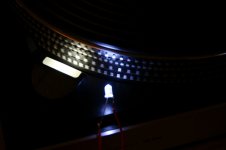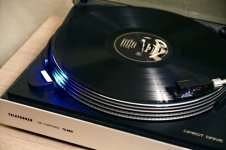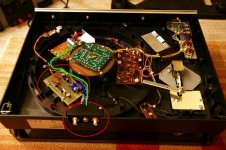There was a thread some time back, a month or two, somebody was looking for a neon lamp for his turn table.
The circuit was provided by another member, if I remember the lamp was driven by a transistor circuit to make it flicker in time to frequency.
Turned out bad caps and good lamp.
Put LED, more reliable, more variety in colors.
A 1N4007 on one leg and a 150 k resistor on the other on a focus type bright LED will give you a mains operated flicker lamp.
22 k to 150 k are all enough for 220 volts mains. the higher rating gives longer life.
Reverse the diode if the LED does not light up.
Some of the new LEDs seem to produce a bright spot a small distance away, and you can focus it through a hole if needed.
I think this is an easy solution, but as a strobe I have not checked it out.
Should take about 5 minutes to make....
The circuit was provided by another member, if I remember the lamp was driven by a transistor circuit to make it flicker in time to frequency.
Turned out bad caps and good lamp.
Put LED, more reliable, more variety in colors.
A 1N4007 on one leg and a 150 k resistor on the other on a focus type bright LED will give you a mains operated flicker lamp.
22 k to 150 k are all enough for 220 volts mains. the higher rating gives longer life.
Reverse the diode if the LED does not light up.
Some of the new LEDs seem to produce a bright spot a small distance away, and you can focus it through a hole if needed.
I think this is an easy solution, but as a strobe I have not checked it out.
Should take about 5 minutes to make....
Last edited:
An LED is brighter than a neon and won't blacken over time. The led will also give a sharper image.
What is your turntable?
You can design a LED to run of the mains using a capacitor, resistor, LED and diode, so very cheep and no need for a transformer. The capacitor must be one rated for connection across the mains.
If your turntable has a low voltage transformer it might be safer to use the the output of that. Again all you need is a capacitor, resistor, LED and diode.
What is your turntable?
You can design a LED to run of the mains using a capacitor, resistor, LED and diode, so very cheep and no need for a transformer. The capacitor must be one rated for connection across the mains.
If your turntable has a low voltage transformer it might be safer to use the the output of that. Again all you need is a capacitor, resistor, LED and diode.
Using the mains AC to drive a strobe is not a good idea. The strobe frequency will drift with the motor speed so it will look like the speed is stable, but it is not. The pulse width will also be wide so the strobe marks on the platter will be fuzzy and blur.
There are low cost digital strobes available that are crystal controlled and use and LED:
Turntable Strobe from Bot Thoughts LLC on Tindie
There is a DIY version available HERE, but I doubt you could built it cheaper than the Tindie strobe. Both will be more accurate and have a narrow pulse width.
There are low cost digital strobes available that are crystal controlled and use and LED:
Turntable Strobe from Bot Thoughts LLC on Tindie
There is a DIY version available HERE, but I doubt you could built it cheaper than the Tindie strobe. Both will be more accurate and have a narrow pulse width.
I built such a circuit inside TT instead of a neon bulb.
DIY Strobe - Turntable Timing Light | Vinyl Engine
(I didn't want the mains voltage to be "inside" the TT because the transformer is also built into a separate stand alone box).
DIY Strobe - Turntable Timing Light | Vinyl Engine
(I didn't want the mains voltage to be "inside" the TT because the transformer is also built into a separate stand alone box).
Unless you live someplace with "unusual" power quality, mains frequency will be plenty accurate for a strobe. Powering a bright white LED from the line, using a capacitor as the dropping element works great. You should use two in parallel, with opposite polarity. That way each protects the other from excessive reverse voltage, the spec for which is usually very low. I add another feature; you can include a pair of zener diodes such that the LEDs only turn on at the peak of the AC waveform, giving a shorter pulse and an even sharper strobe pattern.
Hey guys, thanks for all the info. I appreciate the different approaches. Ill let you know what transpires. Johnmath asked which TT. I'm building a custom unit for my daughter. It's a hobby that keeps me from lurking on street corners with dubious intent. This one will have the motor drive and platter from a Dual CS 505-2 and a tone arm from a Sonab 67s.
The base will be maple and walnut. If there's an interest I'll post some pics as I go.
John
The base will be maple and walnut. If there's an interest I'll post some pics as I go.
John
[A 1N4007 on one leg and a 150 k resistor on the other on a focus type bright LED will give you a mains operated flicker lamp.
22 k to 150 k are all enough for 220 volts mains. the higher rating gives longer life.
Reverse the diode if the LED does not light up.
I think this is an easy solution, but as a strobe I have not checked it out.
Should take about 5 minutes to make....[/QUOTE]
Thank you for that idea.
John
22 k to 150 k are all enough for 220 volts mains. the higher rating gives longer life.
Reverse the diode if the LED does not light up.
I think this is an easy solution, but as a strobe I have not checked it out.
Should take about 5 minutes to make....[/QUOTE]
Thank you for that idea.
John
I think the 505-2 uses a mains voltage synchronous motor. Pitch control is effected by varying the pulley diameter. When the mains frequency is correct and the pulley diameter is set properly, the strobe dots will be static and the speed will be correct.
If the mains frequency is out the strobe dots will still be static, but the pitch will be out. Not much can be down about that because both the motor and strobe are synced to the mains. This is pretty typical of turntables unless they have an electronic speed control.
I expect Canada is similar to Australia. When factories and offices start up, the mains frequency slows down ever so slightly until the generators catch up and balance generation with load. The same happens later in the day when home heating or cooling systems are switched on as people return home.
The network operators must adjust the mains frequency so that synchronous clocks do not forever lose time, so there is a period of catch up when the mains frequency is ever so slightly fast around mid-morning and early evening.
The standard for mains frequency accuracy (off the top of my head) is ~+/- 1%. People with perfect pitch will certainly notice the error listening to records at different times of the day.
If the mains frequency is out the strobe dots will still be static, but the pitch will be out. Not much can be down about that because both the motor and strobe are synced to the mains. This is pretty typical of turntables unless they have an electronic speed control.
I expect Canada is similar to Australia. When factories and offices start up, the mains frequency slows down ever so slightly until the generators catch up and balance generation with load. The same happens later in the day when home heating or cooling systems are switched on as people return home.
The network operators must adjust the mains frequency so that synchronous clocks do not forever lose time, so there is a period of catch up when the mains frequency is ever so slightly fast around mid-morning and early evening.
The standard for mains frequency accuracy (off the top of my head) is ~+/- 1%. People with perfect pitch will certainly notice the error listening to records at different times of the day.
A capacitor in series with a resistor (to limit LED peak current) and a protection diode in reverse polarity across the LED to drive a LED directly from mains power without the power losses and heat of using a large resistor. Use a mains rated 'X2' capacitor as the dropping device. It doesn't dissipate any power. 0.022µF is typically used for 240Vac.
½ wave rectification for the led will give a clearer strobe effect as the LED is off for longer. There's detailed application and safety information for running LEDs of the mains here:
Marc's Technical Pages: Mains LED
½ wave rectification for the led will give a clearer strobe effect as the LED is off for longer. There's detailed application and safety information for running LEDs of the mains here:
Marc's Technical Pages: Mains LED
You can take the crystal or circuit from a quartz clock, and multiply it to the right frequency.
That will then drive the strobe.
You can actually then use a sensor and feedback loop to control the motor speed.
So what you do depends a lot on what you are capable of doing, and how much you want to do.
Here 0.5 Hz variation in mains is allowed, UK is like the area of one of our mid sized states.
That variation in mains frequency may or may not play with your strobe speed and listening experience.
That will then drive the strobe.
You can actually then use a sensor and feedback loop to control the motor speed.
So what you do depends a lot on what you are capable of doing, and how much you want to do.
Here 0.5 Hz variation in mains is allowed, UK is like the area of one of our mid sized states.
That variation in mains frequency may or may not play with your strobe speed and listening experience.
Last edited:
- Home
- Source & Line
- Analogue Source
- TT strobe light


